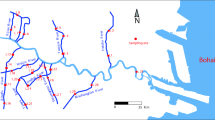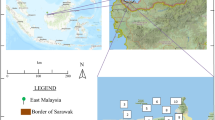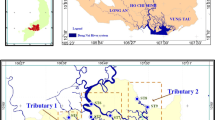Abstract
Dichlorodiphenyltrichloroethanes (DDTs) and heavy metals are ubiquitous contaminants with high bioaccumulation and persistence in the environment, which can have adverse effects on humans and animals. Although applications of DDTs have been banned in many countries, develo** countries like Ethiopia are still using these for agricultural and medicinal purposes. In addition, heavy metals are naturally present in the aquatic environment and distributed globally. In this study, the occurrence, distribution, and ecological risk of DDTs and heavy metals in surface sediments from one of the Ethiopian rift valley lakes were studied. Twenty-five surface sediment samples from Lake Awassa, Ethiopia were collected and analyzed for DDTs and heavy metals. Results showed that concentrations of total DDTs ranged from 3.64 to 40.2 ng/g dry weight. High levels of DDTs were observed in the vicinity of inflow river side and coastal areas with agricultural activities. The heavy metals content were followed the order Zn > Ni > Pb > Cu > Cr > Co > As > Cd > Hg. Correlation analysis and principal components analysis demonstrated that heavy metals were originated from both natural and anthropogenic inputs. The levels of DDE and DDD in surface sediments exceeded the sediment quality guideline values, indicating that adverse effects may occur to the lake. A method based on toxic-response factor for heavy metals revealed that the calculated potential ecological risk indices showed low ecological risk for the water body.




Similar content being viewed by others
References
Amera T, Abate A (2008) An assessment of the pesticide use, practice and hazards in the Ethiopian Rift Valley. African Stockpiles Programme (ASP)
Amina LRS, Mandal R, Nouri MH, Murimboh J, Chakrabart CL, Back MH, Gregoire DC, Schoeder WH (1999) Effect of metal/fulvic acid mole ratios on the binding of Ni(II), Pb(II), Cu(II) and Al(III) by two well-characterized fulvic acids in aqueous model solutions. Anal Chim Acta 402:211–221
Baeyens W, Elskens M, Gillain G, Goeyens G (1998) Biochemical behavior of Cd, Cu, Pb and Zn in the Scheldt estuary during the period 1981–1983. Hydrobiologia 366:15–44
Barakat AO, Mostafa AR, Wade TL, Sweet ST, El-Sayed NB (2012a) Assessment of persistent organochlorine pollutants in sediments from Lake Manzala, Egypt. Mar Pollut Bull 64:1713–1720
Barakat AO, Mostafa AR, Wade TL, Sweet ST, El-Sayed NB (2012b) Spatial distribution and temporal trends of persistent organochlorine pollutants in sediments from Lake Maryut, Alexandria, Egypt. Mar Pollut Bull 64:395–404
Bettinetti R, Giarei C, Provini A (2003) Chemical analysis and sediment toxicity bioassays to assess the contamination of the River Lambro (Northern Italy). Arch Environ Contam Toxicol 45:72–78
Biscoe ML, Mutero CM, Kramer RA (2005) Current policy and status of DDT use for malaria control in Ethiopia, Uganda, Kenya and South Africa., International Water Management Institute: Colombo, Sri Lanka (Working paper 95)
CCME (2002) Canadian sediment quality guidelines for the protection of aquatic life. In: Canadian Environmental Quality Guidelines. Canadian Council of Ministers of the Environment, Winnipeg, MB
de Brito APX, Ueno D, Takahashi S, Tanabe S (2002) Organochlorine and butyltin residues in walleye pollock (Theragra chalcogramma) from Bering Sea, Gulf of Alaska and Japan Sea. Chemosphere 22:401–411
Desta Z (2003) Challenges and opportunities of Ethiopian wetlands: the case of Lake Awassa and its feeders. In: Abebe YD, Geheb K (eds) Proceedings of a seminar on the resource and status of Ethiopia’s wetlands. IUCN, Nairobi, pp 67–75
Doong R, Sun Y, Liao P, Peng C, Wu S (2002) Distribution and fate of organochlorine pesticide residues in sediments from the selected rivers in Taiwan. Chemosphere 48:237–246
Fatoki OS, Mathabatha S (2001) An assessment of heavy metal pollution in the East London and Port Elizabeth harbours. Water SA 27:233–240
Fernandez M, Cuesta S, Jimenez O, Garcia MA, Hernandez LM, Marina ML, Gonzalez MJ (2000) Organochlorine and heavy metal residues in the water/sediment system of the Southeast Regional Park in Madrid, Spain. Chemosphere 41:801–812
Hakanson L (1980) An ecological risk index for aquatic pollution control of sediment ecological approach. Water Res 14:975–1000
Haylamicheal I, Dalvie M (2009) Disposal of obsolete pesticides, the case of Ethiopia. Environ Int 35:667–673
Hites RK, Day HR (1992) Unusual persistence of DDT in some Western USA soils. Bull Environ Contam Toxicol 48:259–264
Hung C, Gong G, Chen H, Hsieh H, Santschi PH, Wade TL, Sericano JL (2007) Relationships between pesticides and organic carbon fractions in sediments of the Danshui River estuary and adjacent coastal areas of Taiwan. Environ Pollut 148:546–554
Ip CCM, ** XD, Zhang G, Wai OWH, Li YS (2007) Trace metal distribution in sediments of the Pearl River Estuary and the surrounding coastal area, South China. Environ Pollut 147:311–323
Jansen H, Hengsdijk H (2006) Agricultural development in the Central Ethiopian Rift valley: a desk-study on water-related issues and knowledge to support a policy dialogue. Plant Research International B.V., Wageningen
Jiang YF, Wang XT, Jia Y, Wang F, Wu MH, Sheng GY, Fu JM (2009) Occurrence, distribution and possible sources of organochlorine pesticides in agricultural soils of Shanghai, China. J Hazard Mater 170:989–997
Jones KC, de Voogt P (1999) Persistent organic pollutants (POPs): state of the science. Environ Pollut 100:209–221
Li FY, Fan ZP, **ao PF, Oh K, Ma XP, Hou W (2009) Contamination, chemical speciation and vertical distribution of heavy metals in soils of an old and large industrial zone in Northeast China. Environ Geol 54:1815–1823
Malferrari D, Brigatti MF, Laurora A, Pini S (2009) Heavy metals in sediments from canals for water supplying and drainage: mobilization and control strategies. J Hazard Mater 161:723–729
Mico C, Recatala L, Peris M, Sanchez J (2006) Assessing heavy metals sources in agricultural soils of an European Mediterranean area by multivariate analysis. Chemosphere 65:863–872
Qiu X, Zhu T, Yao B, Hu J, Hu S (2005) Contribution of dicofol to the current DDT pollution in China. Environ Sci Technol 39:4385–4390
Rodriguez JA, Nanos N, Grau JM, Gil L, Lopez-Arias M (2008) Multiscale analysis of heavy metal contents in Spanish agricultural top soils. Chemosphere 70:1085–1096
Tao S, Li BG, He XC, Liu WX, Shi Z (2007) Spatial and temporal variations and possible sources of dichlorodiphenyltrichloroethane (DDT) and its metabolites in rivers in Tian**, China. Chemosphere 68:10–16
Wade TW, Sweet ST, Klein AG (2008) Assessment of sediment contamination in Casco Bay, Maine, USA. Environ Pollut 152:505–521
Wasswa J, Kiremire BT, Nkedi-Kizza P, Mbabazi J, Ssebugere P (2011) Organochlorine pesticide residues in sediments from the Uganda side of Lake Victoria. Chemosphere 82:130–136
Wenning RJ, Ingersoll CG (eds) (2002) Use of sediment quality guidelines and related tools for the assessment of contaminated sediments: executive summary of the SETAC Pellston Workshop. Society of Environmental Toxicology and Chemistry (SETAC), Pensacola
Wurl O, Obbard JP (2005) Organochlorine pesticides, polychlorinated biphenyls and polybrominated diphenyl ethers in Singapore’s coastal marine sediments. Chemosphere 58:925–933
Yi Y, Yang Z, Zhang S (2011) Ecological risk assessment of heavy metals in sediment and human health risk assessment of heavy metals in fish in the middle and lower reaches of the Yangtze River basin. Environ Pollut 159:2575–2585
Yohannes YB, Ikenaka Y, Nakayama SMM, Saengtienchai A, Watanabe K, Ishizuka M (2013) Organochlorine pesticides and heavy metals in fish from Lake Awassa; Ethiopia: Insights from stable isotope analysis. Chemosphere 91:857–863
Zhou F, Guo HC, Hao ZJ (2007) Spatial distribution of heavy metals in Hong Kong’s marine sediments and their human impacts: A GIS-based chemometric approach. Mar Pollut Bull 54:1372–1384
Zinabu GM, Pearce NJG (2003) Concentrations of heavy metals and related trace elements in some Ethiopian rift-valley lakes and their in-flows. Hydrobiologia 429:171–178
Zinabu GM, Zerihun D (2002) The chemical composition of the effluent from Awassa textile factory and its effects on aquatic biota. SINET: Ethiop J Sci 25:263–274
Acknowledgments
This study was supported in part by a Grant-in-Aid for Scientific Research from the Ministry of Education, Culture, Sports, Science, and Technology of Japan awarded to M. Ishizuka (No. 24248056 and No. 24405004) and Y. Ikenaka (No. 23710038) as well as a Research Fellowship from the Japan Society for the Promotion of Science grant-in-aid awarded to S. Nakayama (No. 2403000402), and the foundation of JSPS Core to Core Program (AA Science Platforms).
Author information
Authors and Affiliations
Corresponding author
Additional information
Responsible editor: Leif Kronberg
Rights and permissions
About this article
Cite this article
Yohannes, Y.B., Ikenaka, Y., Saengtienchai, A. et al. Occurrence, distribution, and ecological risk assessment of DDTs and heavy metals in surface sediments from Lake Awassa—Ethiopian Rift Valley Lake. Environ Sci Pollut Res 20, 8663–8671 (2013). https://doi.org/10.1007/s11356-013-1821-8
Received:
Accepted:
Published:
Issue Date:
DOI: https://doi.org/10.1007/s11356-013-1821-8




